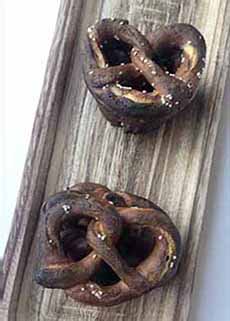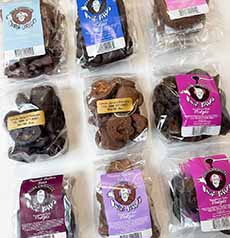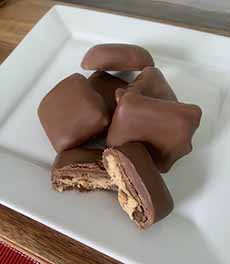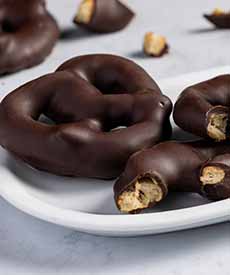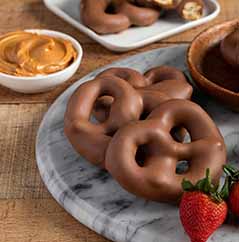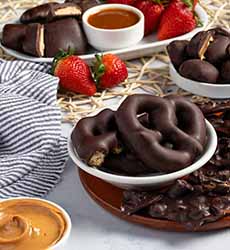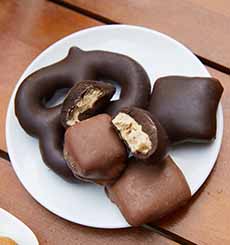Uncle Jerry’s Pretzels: Gifts & Personal Pretzel Fantasies
|
|
Uncle Jerry’s Pretzels are handmade in the land of the Pennsylvania Dutch: Lancaster, Pennsylvania. Hard pretzels are among the most recognizable Pennsylvania Dutch foods*. They’re a legacy of German settlers who came to Pennsylvania in the 18th century and became known, erroneously, as the Pennsylvania Dutch**. So get ready to take a bite of our Top Pick Of The Week, in sizes just right for gift bags, party favors, and stocking stuffers. > The history of chocolate-covered pretzels. > A year of pretzel holidays, below. Uncle Jerry’s Handmade Pennsylvania Dutch Pretzels is a family business that has been crafting artisan pretzels for more than 30 years in rural Lancaster County, Pennsylvania. It’s still run by Uncle Jerry, now with his daughter, Misty. German immigrants, known as the Pennsylvania Dutch, brought pretzels to central southeastern Pennsylvania in the 18th century. Pretzels became a popular snack at markets and county fairs, and pretzel bakeries began to emerge. In fact, the region became known as the Pretzel Belt. More trivia: You’ll taste the tradition that goes into every Uncle Jerry’s pretzel. While it seems as if the recipe for pretzels is pretty simple, we wondered tasted something special in Uncle Jerry’s pretzels. Why, we asked, are Uncle Jerry’s Pretzels are so much more delicious than even the ones from our local farmers’ market? Thus spake the Pretzel Oracle: While everything made here is delicious—whether sweet or savory (i.e., salted), we settled on three favorites for stocking stuffers: one savory and two sweet. Extra Dark Pretzels. Until we tasted these, we’d never given a thought about what happens if you bake pretzel to the “well done” stage. Now, we only want well-done pretzels! Called Extra Dark, this slower-baked-for-a-longer-time version of Uncle Jerry’s Specials (his name for traditional pretzels with the classic medium brown finish) rocked our world. As good as the Specials are, Extra Dark has an even crispier, crunchier texture due to the magic of Maillard. While all pretzels undergo a Maillard reaction‡‡, Extra Dark is ultra-Maillard. We’re sure Dr. Maillard would have loved them. (Check out more about the Maillard Reaction in the footnote.) OMG, so much more exciting than our former fave, the peanut butter cup! Please note that due to the challenge of shipping chocolate in hot weather, the chocolate-enrobed pretzels are seasonal items, from mid-October through mid-April. > Head to UncleJerrysPretzels.com. |
|
|
________________ *Pennsylvania Dutch specialties in addition to pretzels include apple butter, apple dumplings, red beet eggs, sand tarts, scrapple, shoofly pie, and whoopie pie. Here’s more about the traditional cuisine. **“Dutch” is a misspelling of “Deutsch,” the German word for…German. The term is more properly “Pennsylvania German.” The so-called Pennsylvania Dutch have nothing to do with Holland, the Netherlands, or the Dutch language. They originally came from German-speaking areas of Europe. ***Why use these additives? It’s a matter of consumer tastes. Malt syrup, a type of sugar, adds a subtle sweetness and a richer, slightly malty taste. Oil helps to create a soft, chewy interior and a shiny, slightly crisp exterior. †Pretzel Sunday, Bretzelsonndeg is celebrated on the fourth Sunday during Lent in Luxembourg. Pretzel Sunday marks the middle of the Lenten season and can fall on any date between March 1 and April 4. The holiday celebrates love with pretzels and eggs. Men give their sweethearts a pretzel as a token of their love (pretzels are symbolic, representing lovers’ interlocking arms). If the woman reciprocates, she gives the man an egg on Easter Sunday. If the woman is not interested, she gives the man an empty basket. Roles are reversed in leap year. The tradition dates back to the 18th century. The Luxembourgish expression De Kuerf kréien (to receive a basket) means “to be dumped.” ‡Oktoberfest in Munich, Germany begins in mid- or late-September and runs until the first Sunday in October. ‡‡Maillard Reaction. The brown caramel color and deeper flavor that occurs in certain foods—from caramels to barbecued, roasted and seared meats, to roasted coffee beans, to toasted bread, nuts and marshmallows—comes from a reaction between natural sugars and amino acids. This produces brown-colored compounds called melanoidins, which provides not just a brown color but a deeper flavor. It’s a form of non-enzymatic browning that usually requires heat. It’s called the Maillard (my-YARD) reaction after the French physician and chemist Louis Camille Maillard, who first described it in 1912. CHECK OUT WHAT’S HAPPENING ON OUR HOME PAGE, THENIBBLE.COM.
|
||
